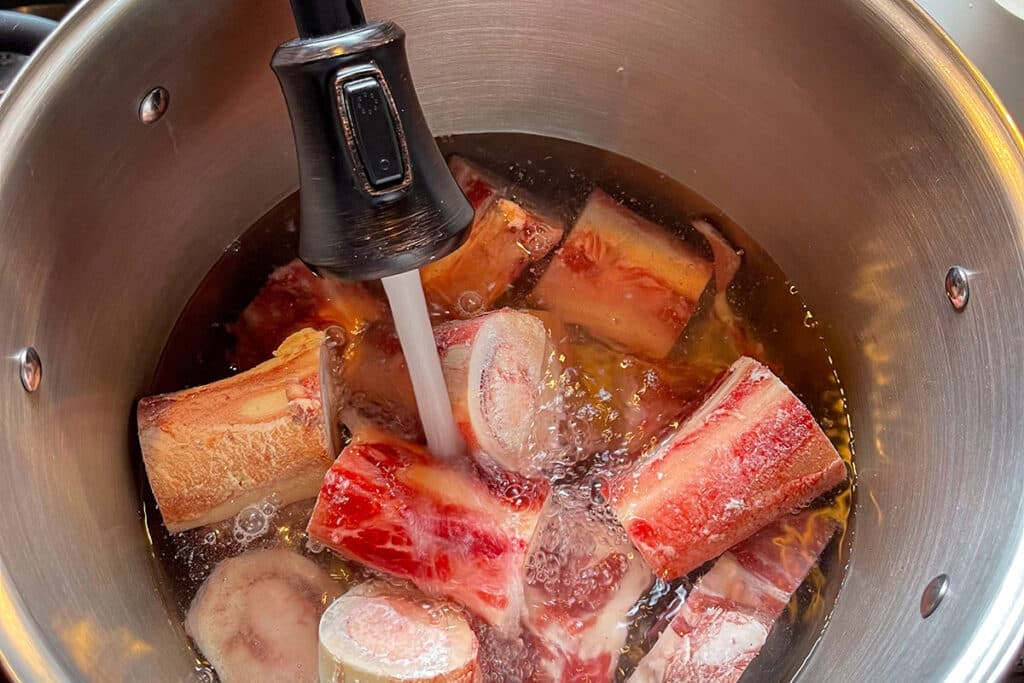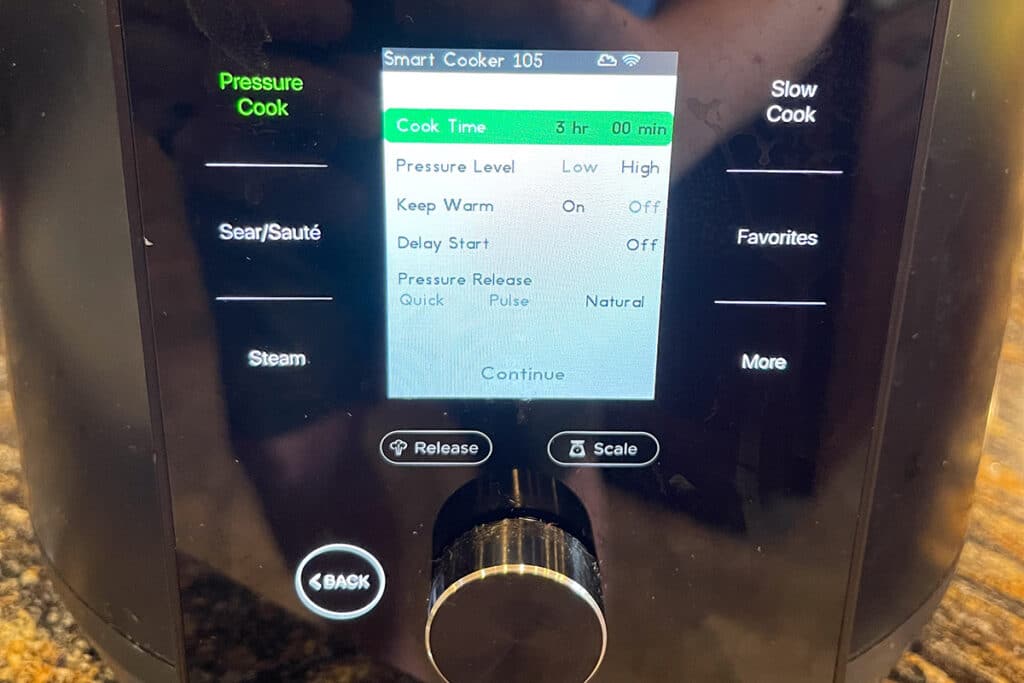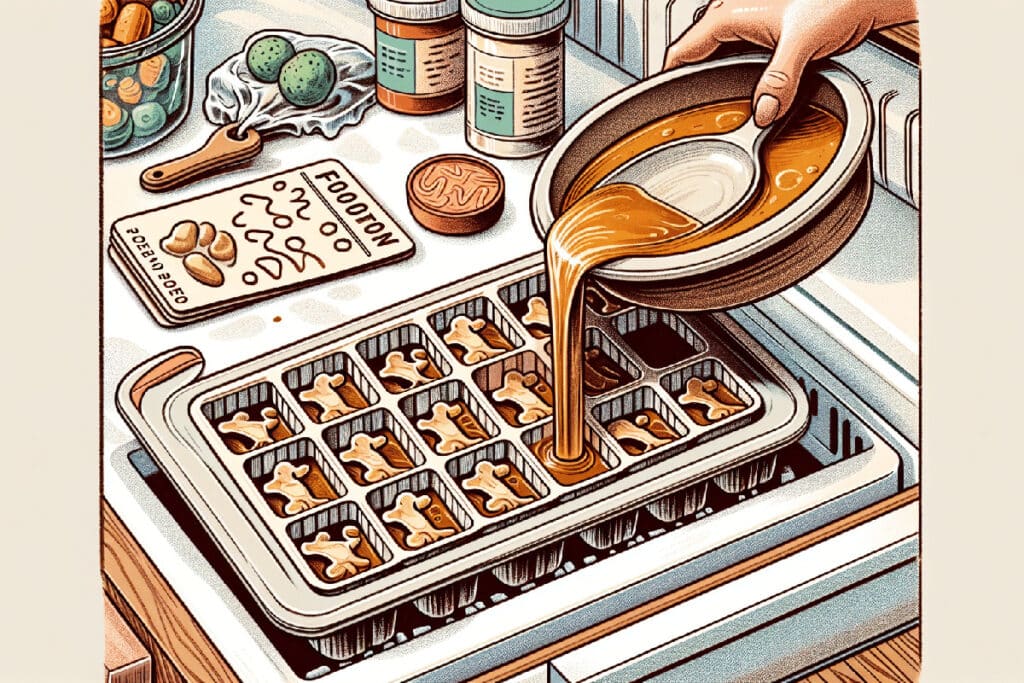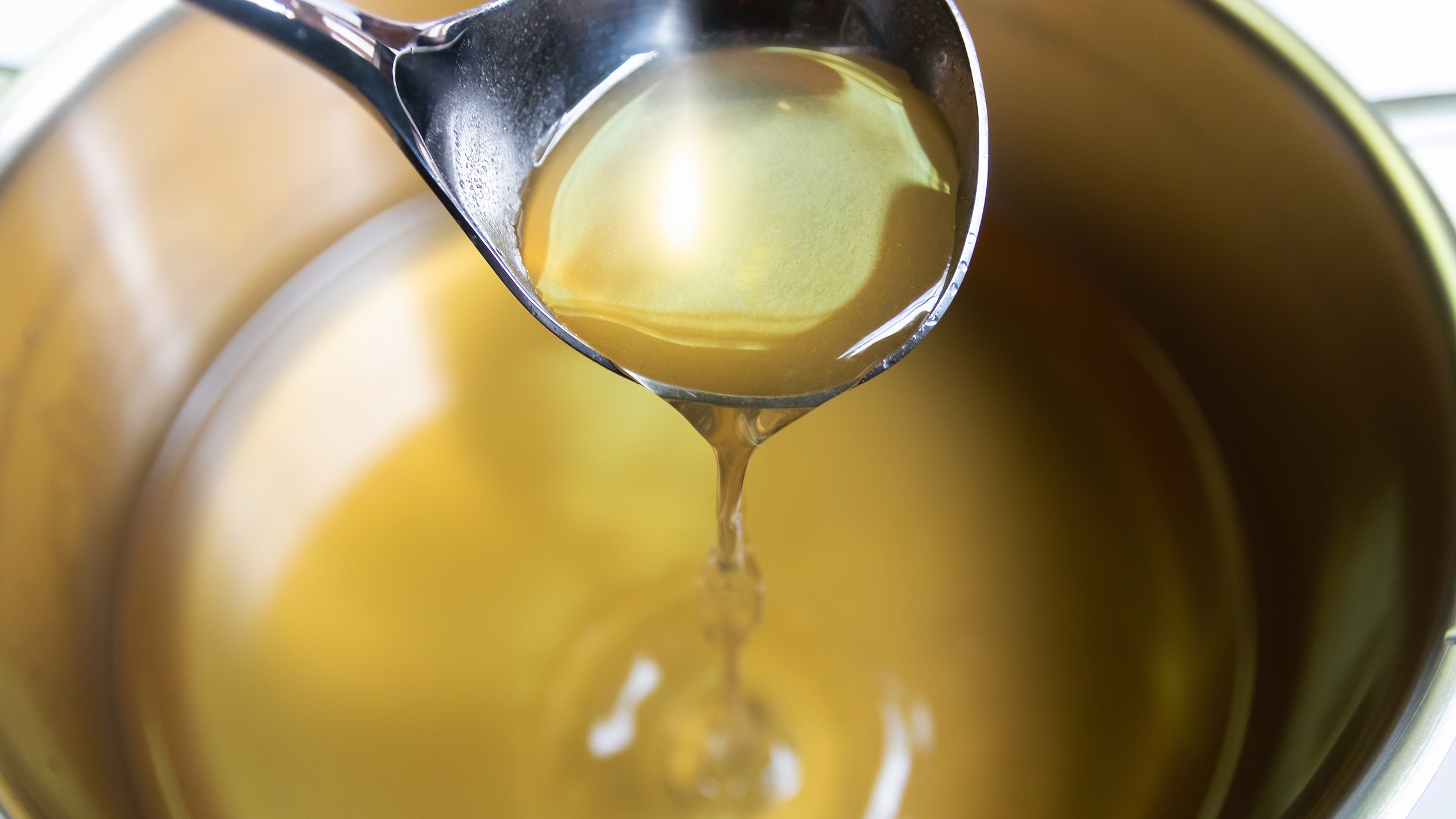Making bone broth for your dog is super simple and it adds a bunch of nutrients at mealtime.
In this article, you’ll learn the essential steps on how to make bone broth for dogs, including careful ingredient selection and preparation tips. Get ready to provide a homemade solution that supports your dog’s vitality and long-term health.
For an even more powerful combo, pair the bone broth with homemade dog food that you can make in the crockpot!
Key Takeaways
- Bone broth for dogs provides health benefits like joint support, boosted immunity, and improved digestion, and you know it’s free of harmful additives when homemade.
- Essential ingredients include raw joint bones, apple cider vinegar to extract nutrients, and dog-safe veggies and herbs to enhance flavor and nutritional value.
- The process of making bone broth will require blanching, roasting, and finally simmering the bones for up to 24 hours.
- An alternative preparation can make a quick turnaround with a pressure cooker.
Table of Contents
The Basics of Bone Broth for Dogs
Bone broth, a nutrient-rich liquid made from simmering bones and connective tissues, offers various health benefits for your furry friend.
So, what makes it such a hit amongst pet owners?
What is Bone Broth?
Bone broth originates from the process of simmering raw animal bones with herbs, vegetables, and other ingredients to create a rich and hearty liquid.
This slow-cooking method allows the nutrients and flavors to infuse into the broth, making it a popular base for soups and stews. The bones cook with dog-friendly herbs and spices for more than a day, which renders the broth richer, heartier, and more flavorful.
This isn’t your ordinary broth. It’s a labor of love that packs a nutritional punch, perfect for those who prepare their own meals!
And don’t worry about the time commitment, because we have a trick up our sleeve for later.
Benefits for Dogs
From supporting joint health to boosting immunity, bone broth is a treasure trove of goodness for your pet. It’s teeming with amino acids, proteins, and glycosaminoglycans that strengthen your dog’s joints and bones. Plus, it aids digestion and bolsters their dog’s immune system, helping them to fight off illness.
Homemade vs. Store-Bought
Making bone broth at home gives you the benefit of knowing exactly what’s going into your pet’s meal. You control the ingredients and ensure the broth is free from harmful additives.
If you do opt for store-bought bone broth, remember to check the ingredient list and ensure it’s made from real bones, not just added natural flavors.
Essential Ingredients for a Dog-Friendly Bone Broth Recipe

With an understanding of the benefits of bone broth, it’s time to delve into the ingredients.
Raw Bones
The star of the show is, of course, the raw bones, including joint bones. Some options for bones include:
- Beef knuckle bones
- Marrow bones
- Chicken feet
- Turkey necks
- Ox tails
Just remember, the more organic and grass-fed the bones, the richer the nutrients and the fat layer in your store bone broth, contributing to healthy skin.
Apple Cider Vinegar
Next up is apple cider vinegar, a crucial component that helps draw out minerals, gelatin, and marrow from the bones.
This enhances the broth’s nutritional value, making it a potent health booster for your dog. Additionally, lemon juice can be used as an alternative to apple cider vinegar for similar benefits.
Vegetables and Herbs
Adding vegetables and herbs to your broth not only enhances its flavor but also ramps up its nutrient profile. Feel free to add dog-friendly herbs and veggies like:
ginger root
parsley
shiitake mushrooms
celery
You don’t have to add herbs and veggies if you don’t have them handy, it’s just a nutritious additive. You may have already added your vegetables to a homemade crockpot meal as well, so maybe they aren’t needed here. It’s your recipe!
Step-by-Step Guide to Making Bone Broth for Dogs
Are you all set to create some homemade bone broth for your pup? Follow this straightforward step-by-step homemade bone broth recipe.
Blanch Them Bones
The first step is to blanch the bones. Top the bones with water in a large stock pot and bring to a boil, simmering for another 10-12 minutes. This will eliminate a large portion of the “off” flavors and impurities like blood, dirt, hair, or other nasties.

Then rinse the bones and spread them out on a cookie sheet.
Roasting Adds Flavor
With your bones spread out, add the vegetables if you plan to include them. Place the tray in a 450-degree oven to get a nice roast on everything.

After about 30 minutes, take them out to mix them around a bit and back in for another 15-30 minutes.
Now, onto the broth…
Slow Cooker Method
The slow cooker method is a set-and-forget method. Fill your cooker with your chosen roasted bones and other ingredients, then cook on high for the first hour.
After that, lower the temperature and let it simmer on low for a full 24-hour period. Crock-pot always has good units, but any slow cooker will do nicely for this.
Stovetop Method
The stovetop method is similar to the slow cooker method, with the difference being that you’d simmer the broth on low heat on your stove for 12-24 hours.
For this method, you need a good-sized stockpot, 8 quarts or more is great. We use a Made In pot at home for stocks as it has nice thick walls to retain heat, and works on induction.
Pressure Cooker Method
I told you we had a trick up our sleeve to skip out on the long cook times. Pop the ingredients in a pressure cooker and set it on high pressure for 3-4 hours with a natural release.
Make sure to have at least a 6-quart pressure cooker on hand, such as this Instant Pot or the Chef IQ cooker as featured here.

Finishing Up
Remember, after the cooking process, strain out the bones and any remaining meat. As much as your dog might enjoy them, cooked bones can splinter and pose a choking hazard.

Serving and Storage Tips for Bone Broth
When your bone broth preparation is complete, it’s time for your pet to enjoy it!
How to Serve Bone Broth
Bone broth can be served alone as a hydrating treat or mixed into your dog’s regular meals. It’s also a great way to add flavor to dry kibble.
Our favorite preparation is to heat some up in the microwave if it was cooled and pour over their 50/50 mix of dry kibble and homemade crockpot dog food.
The serving size depends on your dog’s size, ranging from a few tablespoons for small breeds to up to a cup per day for larger breeds.
Storage Solutions
As for storage, bone broth can be refrigerated for up to five days.

For longer-term storage, freeze it. You could pour it into ice cube trays for easy portioning, especially for smaller dogs.
Customizing Your Dog’s Bone Broth
Much like any soup recipe, you can tailor bone broth to your dog’s tastes.
Adding Nutritious Extras
Adding extras like parsley can freshen your dog’s breath and provide additional nutrients.
You could also add vegetables like kale and green beans after turning off the crockpot to enrich the broth with extra nutrients.
Adjusting Cooking Time and Temperature
The cooking time and temperature can be tweaked to achieve the desired gel-like texture and flavor intensity. Cooking on a low heat setting for 12 to 24 hours ensures maximum extraction of collagen and nutrients from the bones.
Remember the longer you cook, the more the volume of liquid reduces. This leaves the same amount of nutrients in less liquid, but it amplifies the flavor. This is how chefs create the rich sauces in some of their signature dishes.
Cost to Make Bone Broth at Home
What does it cost to make bone broth? Some of the final cost varies based on how much water content remains in the broth. But I’ll use a general assumption that we can make about 2.5 quarts from the bones we used in this recipe.
For the bones, we used 1 package of ox tail (1.27 lbs – $12.69), and 2 packages of ox leg bones (5.3 lbs – $10.54). That totals up to $23.23 for ~2.5 quarts, or, $9.29/qt. That is a little bit more expensive than the nicer bone broths available at our local grocery store ($8.25/qt), but knowing 100% of what’s in ours is great peace of mind for only about $1/qt extra.
Common Mistakes and Troubleshooting
Though the process of creating bone broth for dogs is simple, there are some common pitfalls to be mindful of.
Gel-like Texture Issues
Firstly, achieving a gel-like texture signifies a high gelatin content, which is beneficial for your dog’s joints and digestion. If your broth isn’t gelling, consider using high-collagen bones, adjusting the water level, and ensuring sufficient cooking time to better support your dog’s joints.
Fat Layer Removal
Don’t forget to remove the fat layer after the bone broth initially cools. After being in the refrigerator overnight, a solid layer should form that you can break and remove. A quick restrain and you should have nice and clear broth!

Avoiding Toxic Ingredients
Secondly, it’s crucial to avoid toxic ingredients. Homemade or dog-specific bone broth helps avoid toxins prevalent in human bone broth.
So, when customizing your broth with added seasonings, make sure that the ingredients are safe and suitable for dogs.
Final Thoughts
Bone broth is a nutritious addition to your dog’s diet, offering a host of health benefits. From supporting joint health to boosting immunity, it’s a superfood that’s easy to make at home.
So, why not give it a shot? Your furry friend will surely thank you, and you’ll have the satisfaction of knowing you’re contributing to their health and happiness!
Frequently Asked Questions
Can I use any kind of bones for bone broth?
You can use a variety of bones for bone broth, such as beef knuckle bones, marrow bones, chicken feet, or turkey necks. It’s best to use raw bones from organic, grass-fed sources, especially those that have a good amount of connective tissue.
How long should I cook the bone broth?
Cook the bone broth for 24 hours on a low setting in a slow cooker or on low heat for 12-24 hours on the stovetop for the best results. Pressure cookers can get the job done in maybe 4 hours.
How can I serve bone broth to my dog?
You can serve bone broth to your dog either as a hydrating treat or mixed into their regular meals for extra nutrients. We like to warm it up for about 30 seconds in the microwave to get it liquid again and pour over their kibble/homemade food mix.
How should I store bone broth?
Store bone broth in the refrigerator for up to five days, and if you want to keep it longer, freeze it. Enjoy your bone broth! Remember, it will turn into a jelly-like consistency after cooling. Also, if you see a thick layer form on the top, remove it and that will eliminate most of the fat.
What if my bone broth doesn’t gel?
Don’t worry if your bone broth doesn’t gel, it’s still nutritious. Try using higher-collagen bones, adjusting the water level, and ensuring sufficient cooking time for a gel-like texture.
